China's powerful export engine losing steam amid Covid-19?
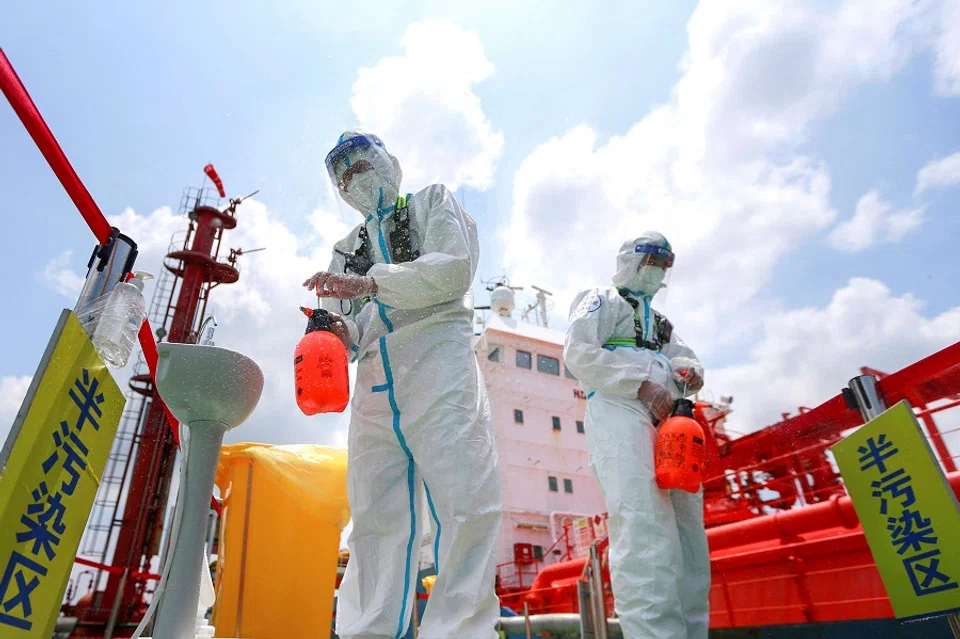
(By Caixin journalists Qu Yunxu, Yang Jinxi, Bai Yujie, Zhang Bingsong and Han Wei)
Shanghai businessman Du Chuankui has been stuck at home for more than a month as the city locked down most of its 25 million people since late March to contain the Covid-19 outbreak. After nearly 20 years in the export industry, Du is now anxious about the future of his business.
Du runs a plant in the Jinshan district of Shanghai's southwestern suburbs, manufacturing massage and beauty devices mainly for overseas customers, with annual sales topping 400 million RMB (US$60 million). The lockdown halted production at Du's plant and he had contacted clients and sought delivery extensions, but Du said that if output does not resume in May, some customers are likely to switch to rivals.
March and April are usually the busiest months for Chinese exporters to sign up orders and ramp up production. But as this year's wave of Covid-19 outbreaks spread, driven by the highly transmissible Omicron variant, strict virus control measures have dramatically disrupted businesses across China.
Exports have been the main driving force powering the recovery of the world's second largest economy since the pandemic hit more than two years ago. China's exporters have experienced seven quarters of rapid growth as the country largely quelled the virus since early 2020 while the rest of the world struggled to contain it. But the engine is losing steam as the latest flare-ups slammed the brakes on growth.
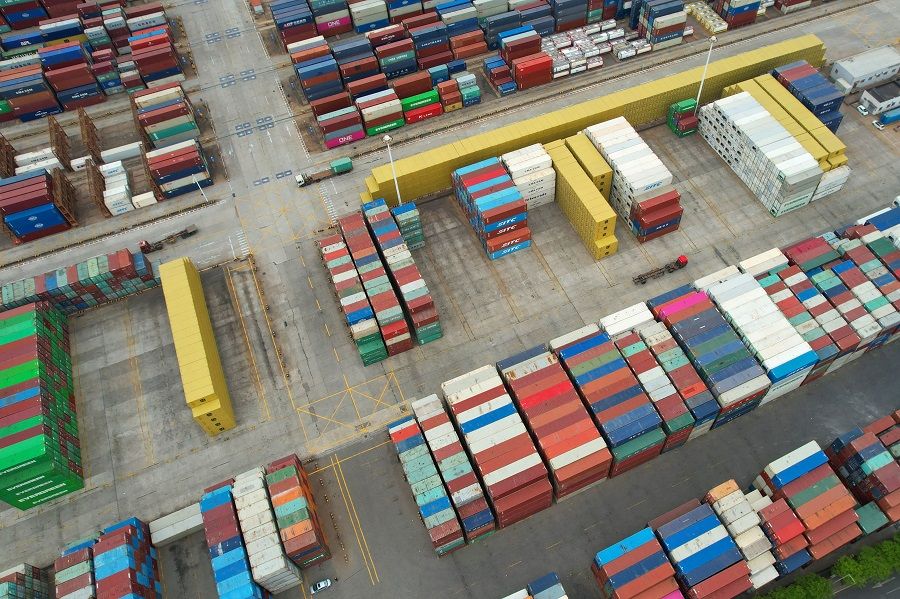
Some exporters say that they are worried that the pandemic disruptions in China will accelerate a global supply chain restructuring away from China as foreign customers steer more orders to Southeast Asia, where governments have scrapped virus control measures. Another threat is that US and European customers will pour more investment into domestic production.
"Overseas customers will no longer put their whole bets on supplies from China," said Xu Yi, founder of trading services provider Mayibida. "Customers may seek alternative suppliers in China, but the question is no one knows where is the next place that will be hit by the outbreak and lockdowns."
"Many orders that were previously placed with Chinese manufacturers are going to domestic producers or diverting to suppliers in Vietnam, Indonesia and Mexico where restrictions are less rigid." - Mayibida founder, Xu Yi
Slowing business activities and export growth
The situation adds up to a perfect storm slamming into China's export growth. According to the General Administration of Customs, China's total trade in goods rose 10.7% to 9.42 trillion RMB in the first quarter of 2022, including a 13.4% increase in exports and a 7.5% rise in imports, compared with gains of 38.7% in exports and 19.3% in imports in the same quarter of 2021.
Economic indicators signal a further slowing in business activity. China's manufacturing contracted in April at the steepest pace in more than two years, a Caixin-sponsored survey showed. Indexes tracking production, new orders and delivery times all plunged to the lowest levels since March 2020.
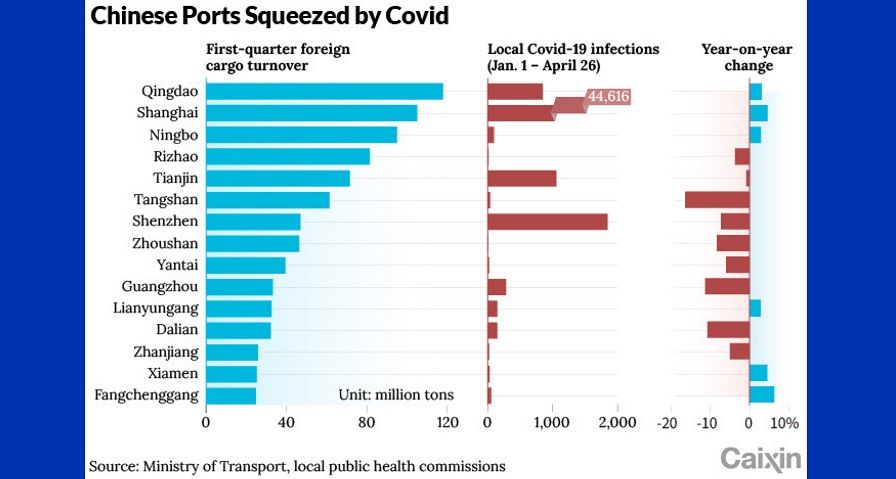
As domestic commerce slows, international logistics disruptions caused by the war in Ukraine are adding more headaches to Chinese traders. The Port of Odessa in Ukraine is a key gateway for Chinese textile products to enter the European market. But as the war drags on, exporters must ship their products to Istanbul in Turkey. The extended logistics chain is adding pressures on exporters' capital chain, one trader said.
Pressures on Chinese traders are also coming from reviving foreign competition as other countries race to relax virus controls and resume trade since late 2021. Many orders that were previously placed with Chinese manufacturers are going to domestic producers or diverting to suppliers in Vietnam, Indonesia and Mexico where restrictions are less rigid, said Mayibida's Xu.
A survey by Mayibida of 100 export enterprises around the Qingdao Port found that nearly half of the companies reported business declines in the first quarter. A similar survey in 2021 showed that only 35% of the companies reported declines. A more worrying finding is that more than 50% of the companies with annual export sales of between 50 million RMB and 100 million RMB reported year-on-year sales drops, compared with 10% a year ago, according to Mayibida.
"It indicates that the Omicron outbreaks have not only affected smaller exporters but also the big players," Mayibida's Xu said.
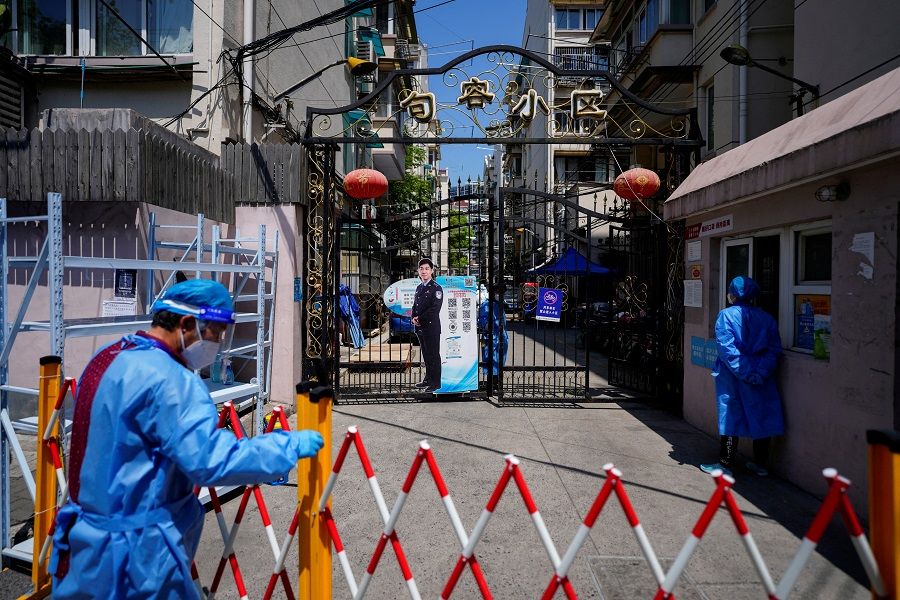
Persistent virus lockdowns affecting industrial hubs such as Shenzhen and Shanghai since March are turning China's export growth around, said a staffer at an export services company. If restrictions continue toughening, the growth will slow further in the following quarters, the person said.
Strengthening headwinds
Guo Hongqin has run a textile export business for 17 years in Ruili, a small city in southwest China's Yunnan province bordering Myanmar. Since September 2020, her business has gradually stalled as repeated Covid-19 flare-ups led to round after round of lockdowns.
"At first I told customers to postpone delivery, but it turned out to be a never-ending delay," Guo said.
In September 2021, Guo started to shift exports away from Ruili to ports in Shenzhen and Ningbo. But that meant a tenfold rise in logistics costs and tripled delivery times. Now, Guo's business is running with orders that are just a quarter of the level before the pandemic.
In late April, the world's largest commodity wholesale market in Yiwu entered partial lockdown after several local infections were reported. The city in Zhejiang province manufactures and exports almost anything from daily necessities to holiday decorations, selling to more than 210 countries and regions.
A survey of 1,500 export companies in mid-April showed that 90% of small and medium-sized exporters failed to deliver on time amid the latest outbreaks, and 90% reduced production due to virus restrictions.
After a short halt in early 2020 when the pandemic started, production in Yiwu quickly recovered. In 2021, the city's exports rose 21.7% to 365.9 billion RMB, accelerating to 57.1% in the first quarter of this year. But there have been worrying signs.

"There have been almost no new orders since mid-March," said Ding Xingjuan, chairman of the Jewelry Accessories Chamber of Commerce of the Yiwu International Trade Mart. Most of Yiwu's accessories makers supply traders in Shanghai, who sell their products worldwide. But as Shanghai entered lockdown, their business was forced to stop, according to Ding.
Trade logistics provider Worldwide Logistics Group has felt the pinch. Many of its exporter customers have slashed deliveries as virus control measures in several cities whacked production. Uncertainties are hindering both exporters and importers in accepting or placing orders, said Lin Jie, founder of Worldwide Logistics.
The uncertainties may force companies to fail in fulfilling contracts, costing them overseas customers, Mayibida's Xu said.
A survey of 1,500 export companies in mid-April showed that 90% of small and medium-sized exporters failed to deliver on time amid the latest outbreaks, and 90% reduced production due to virus restrictions. Rising material and logistics costs have also squeezed business.
Warehouses are full due to delayed deliveries, and ships are waiting in longer lines to load or unload.
Cargo turnover at major Chinese ports, a key trading indicator, declined 5.1% in mid-April compared with a year ago, data from China Port Association showed. Meanwhile, turnover of foreign cargoes dropped 4.9%.
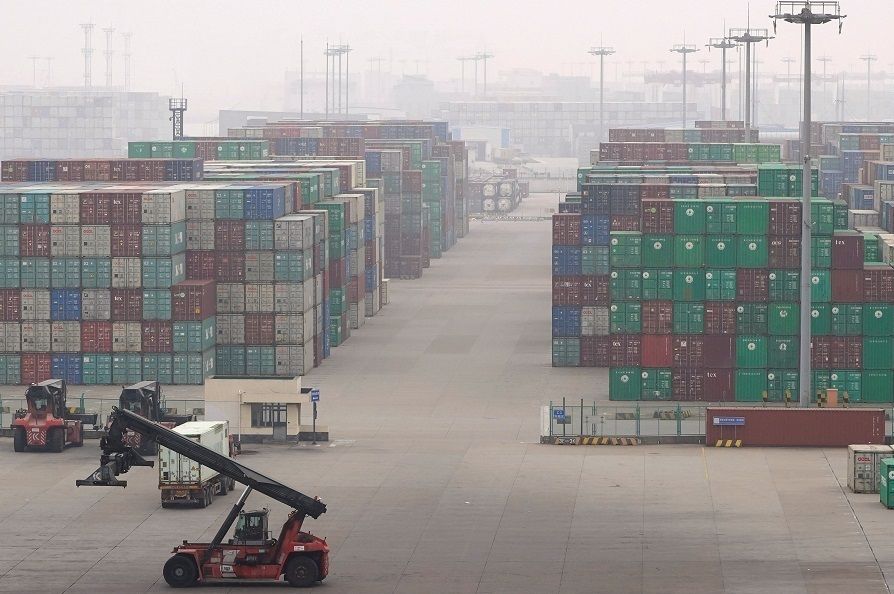
Although global shipping has gradually recovered from the chaotic 2020, growing congestion at the Port of Shanghai, the world's largest container port, is fuelling fresh concerns about supply chain disruptions. The lack of workers at the port and truck drivers for land transport caused by lockdowns are hindering operations. Warehouses are full due to delayed deliveries, and ships are waiting in longer lines to load or unload.
Port congestion and growing changes in shipping schedules are posing more uncertainties to exporters. Zhang Xiaojian, a manager at shipping service agent Shanghai Xiaxuan International Logistics Co., said that the road transportation shortage has made it difficult for exporters to deliver products to the port on time.
Furthermore, companies may face penalties for missing delivery schedules.
"All the products are done but can't be delivered," said a garment exporter. "If we miss the season, there will be risks of penalties."
Vietnam government data showed that the country's first-quarter exports rose 12.9% to US$88.6 billion, led by surges in smartphone components, electronics and computer parts.
Competing for orders
While Chinese exporters struggle with disruptions, upbeat figures from neighboring countries further raised fears that they are losing customers to rivals in an acceleration of global supply chain relocation.
Vietnam government data showed that the country's first-quarter exports rose 12.9% to US$88.6 billion, led by surges in smartphone components, electronics and computer parts. The Southeast Asian country, a major competitor to Chinese exporters, scrapped virus controls and fully reopened earlier this year.
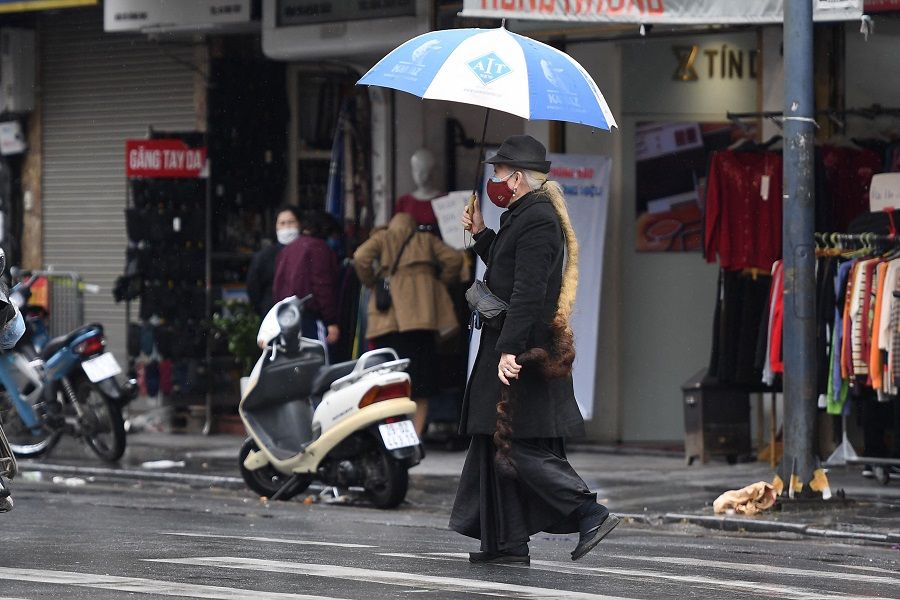
According to Citic Securities, exports to the US from Vietnam and Thailand rose more than 20% since September 2021. Meanwhile, the share of US imports from China slid from 19.7% to 18%.
"Production in Southeast Asia has returned to normal, and new order transactions in Thailand, Vietnam and Indonesia are much more active than China," said Worldwide Logistics' Lin. But the substitutions will be temporary, and the situation will change when supply chains in China return to normal, Lin shared.
"Southeast Asian countries are still unable to compete with China in terms of logistics efficiency, production capacity and stability," Lin said. A large-scale supply chain relocation will require heavy investments and long-term work, he said.
But if China's uncertainties continue for long and customers shift more large, stable orders to Southeast Asia and invest in new production capacity, the relocation will become a real threat to Chinese manufacturers, Lin said.
A more pressing challenge is from developed economies as the US and Europe move manufacturing back to domestic markets.
Export industry insiders told Caixin that they are not too worried about competition from Southeast Asia as the supply chain restructuring has been underway for years and is an inevitable trend as Chinese manufacturers move toward the higher end of the industrial chain.

A more pressing challenge is from developed economies as the US and Europe move manufacturing back to domestic markets. According to Citic Securities, US manufacturing capacity utilisation reached 78.7% in March, the highest since 2016. Meanwhile, the rate in the eurozone was 82.4%, returning to the pre-pandemic level.
As international shipping costs surge, customers in the US and Europe may increasingly shift to domestic production instead of importing from China, Xu said.
Policy support
Weakening exports have sparked worries about China's economic outlook. The economy expanded by a better-than-expected 4.8% in the first quarter of 2022, but analysts warned that production and supply chain disruptions will drag down growth in the following months.
... policies such as tax rebates and financial support have mainly benefited large companies and have been hard to access for smaller exporters...
Policymakers since early April have stepped up efforts to stabilise the economy and restore market confidence. On 13 April, the State Council at a meeting chaired by Premier Li Keqiang announced expanded tax rebate programmes to support exporters. Then on 28 April, the Ministry of Commerce pledged more financial and taxation support to the export industry.
Stronger signals came on 29 April when the Politburo, the top decision-making body, issued a sweeping set of pledges to bolster the economy. On 5 May, the State Council again vowed to support resuming production in the manufacturing industry and streamline logistics flows while pledging more credit support.
But policies such as tax rebates and financial support have mainly benefited large companies and have been hard to access for smaller exporters, industry sources said. An executive at a state-owned bank said that banks have a limited number of financing tools to support smaller exporters due to concerns over financial risks.

Compared with preferential policies from government pledges, exporters felt a more immediate boost from the recent depreciation of the RMB, several industry sources told Caixin. Since 19 April, the RMB has slipped sharply to its weakest level in more than a year towards 6.6 RMB per dollar after a few months of trading in a narrow range between 6.3 and 6.4, reflecting concerns surrounding China's growth outlook and a surge in US Treasury yields.
The weaker RMB benefits Chinese exporters by making their products cheaper and more competitive. But at the same time, the depreciation will trigger risks of capital outflow, analysts said.
A more pressing need for traders such as Du in Shanghai is to resume production. The good news is that factories in Shanghai and neighboring regions have picked up the pace to restart production lines. On 5 May, Du's factory called back 50 workers to reopen one-third of production capacity.
"[Workers] sleep on the floor of the plant, and there will be 200 more returning within a week," Du said.
(Sun Yanran, Yu Hairong, Zhao Xuan, Wang Shihan contributed to this story.)
This article was first published by Caixin Global as "Cover Story: Why Is China's Powerful Export Engine Losing Steam?". Caixin Global is one of the most respected sources for macroeconomic, financial and business news and information about China.
Related: Best of both worlds: China wants both zero-Covid and economic growth | Shanghai's Covid shutdown is disrupting domestic and global supply chains | Can Shanghai meet its zero-Covid deadline and resume production? | China gears up for grimmer economic outlook | Stability and growth: Two Sessions' government work report spells out what China wants
